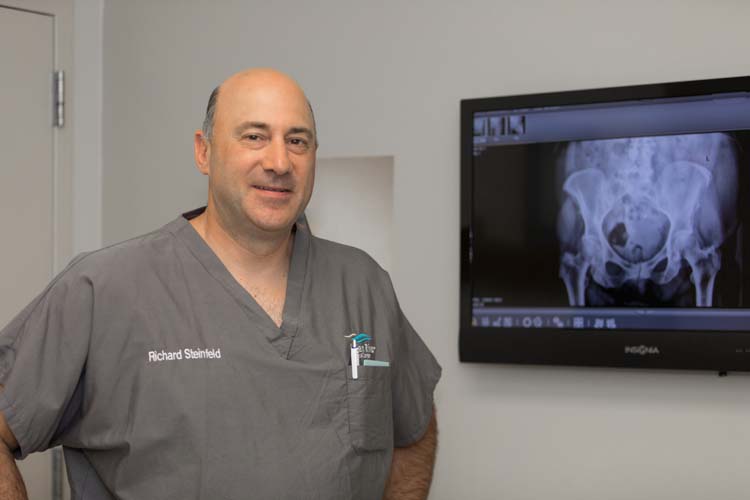
Looking for some straight talk on hip replacements?
Then you might do well to spend some time in conversation with Dr. Richard Steinfeld at the Orthopaedic Center of Vero Beach.
This particular orthopedic surgeon has a five-star rating with WebMD. He earned his medical degree at the New Jersey Medical School and served both his internship and residency at the famed Mayo Clinic’s Graduate School of Medicine in Rochester, Minn.
He also has some 16 years of experience here in Vero Beach, making him uniquely qualified to educate and advise just about any of the more than 425,000 Americans who will have a hip replaced this year.
Hip replacements have become a very big business.
Close to 3 million Americans are walking around with artificial hips and the National Center for Health Statistics estimates that, within a decade, as many as a million people a year will be having hip replacement surgery.
Not surprisingly, there are a number of different surgical procedures currently being used, including “direct lateral, posterior and direct anterior.”
But while some orthopedic centers seem to be constantly touting “the newest” surgeries, Steinfeld takes a more measured approach and points out that what’s sometimes pitched as “new” has actually been around for quite a while.
Specifically, Steinfeld points to the minimally invasive “direct anterior” hip replacement procedure.
“I think [this procedure] is becoming more popular,” Steinfeld says. “I have been doing them for about two-and-half to three years. But it’s not a new approach or concept. It was used many, many, many years ago, for instance, for children that may have [had] an infection in their hips but it wasn’t really popularized for hip replacement because the majority of surgeons did that in a different mechanism through the back side.”
The University of Washington’s Orthopedic and Sports Medicine Center elaborates, saying “traditional hip replacement surgery involves making an incision on the side of the hip (lateral approach) or the back of the hip (posterior approach). Both techniques involve detachment of muscles and tendons from the hip in order to replace the joint but the detachment of these muscles may result in increased pain after surgery and often prolongs the time to fully recover by months or even years. Failure of these muscles to heal after surgery may increase the risk of hip dislocation which is the leading cause of hip replacement failure.”
Steinfeld’s direct anterior hip replacement technique, meanwhile, is a minimally invasive surgical technique which the same Orthopedic and Sports Center says “allows the joint to be replaced by moving muscles aside along their natural tissue planes, without detaching any tendons. This often results in quicker recovery, less pain and more normal function after hip replacement. Because the tendons aren’t detached from the hip during direct anterior hip replacement, hip precautions are typically not necessary. This allows patients to return to normal daily activities shortly after surgery with a reduced risk of dislocation.”
There is a caveat, however. Arthritis Health, for example, cautions that the direct anterior approach “is a technically demanding surgery. Surgeons face a steep learning curve for this procedure.”
Steinfeld is clearly over beyond that curve. “I probably have done close to about 40 [direct anterior hip replacements] now,” he says.
Nevertheless, despite the advantages of the minimally-invasive direct anterior technique he likes, Steinfeld is well aware there is no “one size fits all” procedure for hip replacements. For example, he matter-of-factly points out, “I think [the direct anterior procedure] is harder to do on a very large person; a person with a very large abdomen where it’s going to hang over where you are trying to operate.”
Steinfeld also can’t resist pointing out that minimally invasive doesn’t mean robotic. “I was in this hip replacement this morning and I was thinking about this. There are things that we do that are really about judgment and how they feel. And I was thinking, ‘How is a robot going to do this?’ Basically you feel, for instance, putting the hip back in place [or] the tension on those tissues. You have to develop over time [the ability] to feel if it’s appropriate. How can a robot do that?”
Robots aside, it’s probably a good thing Steinfeld is a surgeon. He’d make a terrible salesman. He isn’t impressed by the newest, shiniest toy on the shelf. He cares about results.
“The issue – whether it’s a direct anterior approach or a posterior approach or anterior lateral approach – is that the procedure is done correctly and that is the most important thing.”
Dr. Richard Steinfeld is with the Orthopaedic Center of Vero Beach at 1285 36th Street, Suite 100 and the Indian River Medical Center. His office phone number is 772-778-2009.



